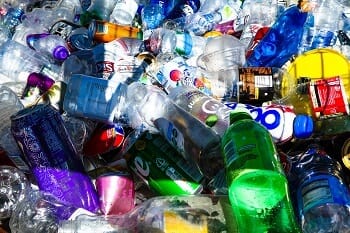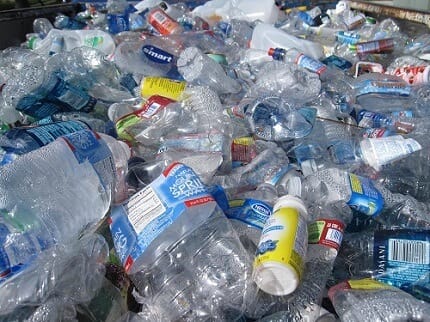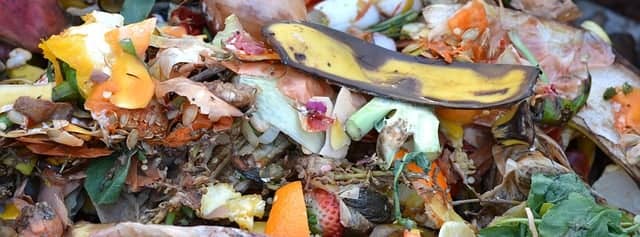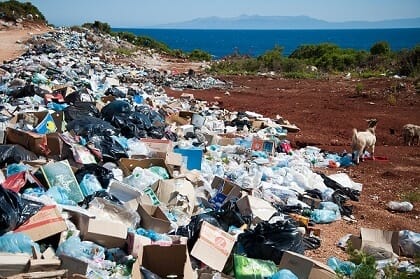Other than buying less stuff, recycling is the next most effective way to save the environment. Recycling lessens the need to extract new resources by using waste to make new products. Problem is, many people don’t know what they can or can’t recycle. Even worse, recycling the wrong stuff can make other waste unrecyclable. This list of 101 recycling tips, tricks and facts will help you do it right:

Recycling Tips
- Know what your local recycling facility can and can’t recycle. Facilities have different equipment and may not be able to accept all recyclables.
- Styrofoam is not recyclable.
- Prepare glass containers for recycling by rinsing them with water.
- Labels on glass containers do not have to be removed. They are separated or burned during the crushing or melting process.
- Tissue, waxed and carbon papers are not recyclable.
- Remove plastic tops from the plastic containers being recycled and rinse containers with water.
- Crushing containers will help save space while storing them in your recycling bin.

Recycling Facts (Cardboard and Paper)
- One ton of recycled cardboard only takes 75% of the energy required to make brand-new cardboard.
- Over 90% of all products shipped in the U.S. are packaged in corrugated boxes. This adds up to over 400 billion square feet of cardboard.
- Approximately 100 billion cardboard boxes are produced each year in the U.S.
- One ton of recycled cardboard saves 46 gallons of oil.
- One ton of recycled cardboard saves 9 cubic yards of landfill space.
- Recycling one ton of paper saves 4,100 kWh of energy.
- Americans use 85 million tons of paper each year. This is equal to about 680 pounds per person. Most of this does not get recycled.
- Paper waste is 70% of the total waste in offices.
- Recycling one ton of paper saves 7,000 gallons of water.
- The average office worker uses 10,000 sheets of paper per year.
- American businesses use around 21 million tons of paper – with about 750,000 copies made every minute.
- Each ton of recycled paper saves 17 mature trees.
- Approximately 1 billion trees’ worth of paper is thrown away every year in the U.S.
- Recycling cardboard only takes 7% of the energy needed to make cardboard from virgin materials.
- Recycling one ton of paper saves 79 barrels (380 gallons) of oil.
- One tree has the ability to filter up to 60 pounds of pollutants from the air each year. That means that when 1 ton of paper is not recycled, 1,020 pounds of pollutants are not removed from the air.
- Recycling one ton of paper prevents 60 pounds of air pollutants from being released.
- 24 trees are cut down to make 1 ton of newspaper. Recycling a stack of newspapers just 3 feet high saves one tree.
- Around 80% of retailers and grocers recycle cardboard.
- 70% of corrugated cardboard is recovered for recycling.
- Recycling cardboard only takes 75% of the energy required to make brand-new cardboard.
- One ton of recycled cardboard saves 9 cubic yards of landfill space.
- Every year Americans throw away enough office paper to build a 12 ft high wall from Seattle to New York.
- The amount of wood and paper that is thrown away each year is enough to heat 50,000,000 homes for 20 years.

Recycling Facts (Metals)
- The average person has the opportunity to recycle more than 25,000 cans in their lifetime.
- Aluminum can be recycled and back on a grocery store shelf as a brand-new can in as little as 60 days.
- Aluminum can be recycled forever without any loss of quality.
- Aluminum can be recycled using only 5% of the energy used to make the product from new materials.
- Recycling a single aluminum can saves enough energy to power a TV for 3 hours.
- Recycling one ton of steel saves 642 kWh of energy, 1.8 barrels (76 gallons) of oil, 10.9 million BTUs of energy and 4 cubic yards of landfill space.
- 75% of all aluminum produced in the US is still around today.
- Aluminum cans are probably the most recycled item, at least in the United States.
- Most beverage cans are made of aluminum, even though there are other products that go into them as well.
- If you throw away your aluminum cans, they can stay in that can form for up to 500 years or more.
- There are over 80 billion aluminum cans used each and every year around the world.
- Aluminum used to be more valuable than gold many years ago.

Recycling Facts (Glass)
- A glass bottle would take 4,000 years or more to decompose.
- Glass is 100% recyclable and can be recycled endlessly without loss of quality or purity.
- More than 28 billion glass bottles and jars are sent to landfills every year. That’s enough to fill two Empire State Buildings every three weeks.
- Recycling one glass bottle saves enough energy to light a 100-watt light bulb for four hours.
- Recycling one ton of glass saves 42 kWh of energy, 0.12 barrels (5 gallons) of oil, 714,286 Btu’s of energy, 2 cubic yards of landfill space, and 7.5 pounds of air pollutants from being released.
- Although glass is 100% recyclable, curbside glass recycling programs are starting to disappear in the US due to cost.
- Avoid breaking the glass as this may make the glass difficult to sort or unacceptable for recycling.

Recycling Facts (Plastic)
- Plastic bags can take up to 1,000 years to decompose.
- Recycling one ton of plastic saves the equivalent of 1,000–2,000 gallons of gasoline.
- Recycling plastic saves twice as much energy as burning it in an incinerator.
- Styrofoam never decomposes.
- The world produces more than 14 million tons of polystyrene (plastic foam) each year.
- Recycling one ton of plastic bottles saves the equivalent energy usage of a two-person household for one year.
- Recycling one ton of plastic saves 5,774 kWh of energy, 16.3 barrels (685 gallons) of oil, 98 million BTUs of energy, and 30 cubic yards of landfill space.
- 2.5 million plastic bottles are thrown away every hour in America.
- Recycling plastic takes 88% less energy than making it from raw materials.
- Enough plastic is thrown away each year to circle the earth four times.
- Only 23% of disposable water bottles are recycled.
- Plastic bottles are often recycled into downgraded products, like carpets and fiberfill for jackets.
- Recycling plastic back into food-grade plastic requires more energy and labour compared to converting recycled plastic into fibre for apparel and carpeting.
- Recycling five plastic bottles can create material to create one square foot of carpet.
- Plastic bags that are thrown into the ocean can kill over a million sea creatures a year.
- Over 91% of all plastic ever created has not been recycled.
- By 2050, there will be more plastic in the ocean than fish (by weight).
- Americans throw away 25 billion Styrofoam coffee cups every year.
- Most recycling machines can’t recycle single-use plastic straws because they’re too small and light.
- There is more plastic in the ocean than there are stars in the Milky Way.
- Plastic does not biodegrade (but smart people on working on this). Plastic breaks down into smaller pieces of plastic, called microplastics. These microplastics make their way into our bodies through groundwater and our food supply.
- Across the globe, nearly 1 trillion single-use plastic bags are used every year.
- The majority of plastic bags are thrown into the trash to sit in landfills. An easy way to reduce your use of plastic bags is to bring your own reusable bag.

Recycling Facts (Organic Waste)
- About one-third of all food produced is discarded as waste.
- Nearly half of the food in the U.S. goes is lost to waste – approximately 3,000 pounds per second.
- Only about 5% of food is diverted from landfill.
- The U.S. produces approximately 34 million tons of food waste each year.
- Food scraps make up almost 12% of the municipal solid waste generated in the U.S.
- Food is the largest component of municipal solid waste at about 22%.
- Over 61% of food waste occurs in the home.
- Food waste is equal to 74kg (163 lbs) per person/yr (UK) – more than the average body weight.
- The amount of food wasted as a percentage is relatively the same in the developed world as in the developing world.

Recycling Facts (Landfills)
- Over 60% of the trash that ends up in the trash can could be recycled.
- Most dumps are made up of a third of packaging materials that could be recycled.
- In 2014, the US generated 258 million tons of municipal solid waste.
- The most thrown-away products in America include diapers, pens, razor blades, tires and aluminum – all of which can be used to be recycled into other products.
- About 11 million tons of textiles end up in US landfills yearly — an average of about 70 pounds per person.
- The EPA estimates that 75% of the American waste stream is recyclable, but we only recycle about 30% of it. Even though 94% of the US population has access to some type of recycling program.
- Almost 60% of US landfills will run out of space in the next 5 years.
- Over 11 million tons of glass bottles and jars are thrown into landfills each year.

Recycling Facts (Miscellaneous)
- One-third of British women consider an outfit old after it has been worn once or twice.
- Over 47% of materials harvested for apparel manufacturing don’t make it into the garment.
- The average person generates 4.4 pounds of solid waste every day.
- Over 94% of the U.S. population has access to some type of recycling program.
- Americans generate an additional 5 million tons of waste during the holidays.
- Americans throw away enough trash in an average year to circle the earth 24 times.
- On average, it costs $30 per ton to recycle trash, $50 to send it to the landfill and $65 to $75 to incinerate it.
- Electronic waste, or e-waste, represents only 2% of trash in a landfill in the US but equals up to 70% of overall toxic waste.
- Due to the fact that people aren’t recycling as much as they should, the rainforests are actually getting cut down by about 100 acres a minute.
- Recycling helps to conserve energy, and as a result, fewer greenhouse gasses are emitted.
- Recycling helps to conserve our natural resources like coal, oil and gas.

Recycling (Bonus Fact)
- Recycling has been around for thousands of years. Recycling as an idea was something that households did to conserve and reuse materials because goods could not be made as quickly and cheaply before the industrial revolution.
If you have never considered recycling, or have thought about it and thought that it would really not be worth your while, you may want to think again. Recycling and sustainability can help you save money, but more importantly, it is much better for the environment. Recycling, composting and waste reduction all help to reduce pollution and reduce the use of earth’s natural resources.
Recycling is easy to do and doesn’t take much extra effort. If more people did it, then the world would be a much cleaner place to be. In order to work toward a sustainable planet that will be around for many more years to come, people will need to do their part. Today, we aren’t doing enough to take care of the planet, which is why we really need to learn more about recycling.
Sources:
Pingback: Are Electric Cars More Climate-Friendly? - Ecological Crusader
Pingback: 10 Easy Zero-Waste Swaps for Your Home to Reduce Waste Today - Ecological Crusader
Pingback: 7 Powerful Human Activities That Will Drastically Reduce Carbon Emissions and Slow Climate Change - Ecological Crusader
Comments are closed.